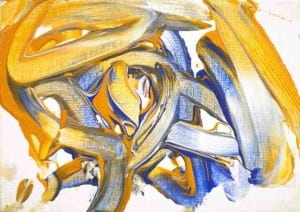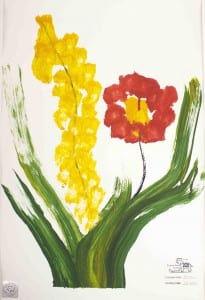Art by Animals opens today
By Jack Ashby, on 1 February 2012
Today the newest exhibition at the Grant Museum opens and it’s probably not something many people will have seen before. Art by Animals is an exhibition of paintings by orang-utans, a chimp, elephants and a gorilla, and to be honest, most of them are better than I could do.
When our co-curators Michael Tuck, a graduate from the UCL Slade School of Fine Art, and artist Will Tuck, first approached me about a year ago I have to admit to being shocked at the elephant painting of a flower pot – it truly displays the incredible dexterity of the elephant’s trunk, but is it art?
Here’s a video about it.
That’s the big question we are asking, and personally the artworks have actually got me thinking more about human art as well as the intentions of the ape artists. We are exploring the links between human and animal behaviours this term in our Humanimals Season. I’m not a fan of anthropomorphising animal behaviour – I think that what animals do in the wild is far more interesting than anything we could lay a claim to being human-like behaviour. There are plenty of examples of animals expressing themselves creatively in nature. Play is a big part of the development of many animals and I’ve certainly seen a lot of wild animals seemingly only doing something for fun. Aesthetics is the key to a bowerbird’s display bower (otherwise why would they be so picky about only decorating them with objects of single colour – it can’t all be about displaying their foraging skills).
As well as a bowerbird, this exhibition displays overtly human behaviour (painting) but I hope that it will suggest a level of natural creativity in the animal world. If that’s the case, where does creativity end and art begin?
All the artworks can be seen here.
The way that the elephants are trained (essentially they learn what kind of brush strokes to perform when their handler strokes their ear in a certain way) has led most people interested in animal art to debunk what elephants do as non-creative. The artist, zoologist and chimp art expert Dr Desmond Morris wrote this article explaining how it is done. But the way the apes paint really does seem to be expressive, and Abstract Expressionists in the 1960s and 70s, influenced by Freud’s work, raised the possibility that if human mark-making expresses something of the artist’s subconscious, the same may be true for chimps.
Talking to Mike and Will Tuck, what really fascinated me is that the apes decide when their paintings are finished – given a load of paper and some paint, they will choose to finish one painting and start another – doesn’t that say something about their artistic intentions? There is an old joke about abstract paintings being hung upside-down, but when we were hanging the ape paintings they really do only “work” one way up. Whether it’s the same way as the apes intended, or whether it speaks only to human artistic sensibilities we’ll probably never know, but it certainly got me thinking.
UPDATE: Due to the the popularity of Art By Animals, we have decided to extend the exhibition dates until 13 April 2012 (but note that UCL and the Museum are closed for Easter from 5-11 April 2012 inclusive).
The Grant Museum is open from 1-5pm Monday to Friday, with a special Saturday opening 11am-4pm on 10th March 2012. Admission is free.
Jack Ashby is the Manager of the Grant Museum of Zoology.
14 Responses to “Art by Animals opens today”
- 1
-
2
Rachael Sparks wrote on 1 February 2012:

Looks like the exhibition has got some attention: the BBC has put this up – http://www.bbc.co.uk/news/uk-england-london-16835258
-
3
Daniel Morse wrote on 2 February 2012:
“Is it art” is, I think, the wrong question. That judgement call is up to each individual observer, and I think the whole “what is art” quagmire threatens to sidetrack the important issue here, namely are the apes (I think we can discount the elephants in this instance) expressing themselves through this visual medium? Have they been observed expressing themselves through other methods, e.g. sculpture, storytelling (via signs and/or sounds), music or other vocal efforts? I think it’s about possessing a level of abstraction beyond the merely factual or necessary. Do they, in any way, “make things up”? (i.e. For no obvious gain – I believe that they’ve been observed to “lie” about food.) I suspect this is closely related to the question as to whether animals do things “for fun”.
-
4
Rachael Sparks wrote on 3 February 2012:

I think the real question is whether the animals are the ones making the decisions about what to do, choice of colour, how to deploy the brush etc. The trainer squeezing the elephant’s ear, or putting a colour on the brush: that’s not animal art. The ape stuff: sure, why not?
-
5
Art by Animals comes to London – ikonotv wrote on 13 February 2012:

[…] art from several species of animal, including paintings by elephants and apes, starts next week at UCL’s Grant Museum of Zoology in collaboration with a graduate from the UCL Slade School of Fine […]
-
6
Anat Pick wrote on 24 February 2012:
It’s interesting that none of the comments so far address the issue of animal captivity which clearly underlies the creative output this otherwise interesting project explores. The first image in the video clip is of an ape behind bars. Whether or not “this is art” is secondary to the cardinal issue of *power* which seems to fly under the radar of the human responses. These animal artworks cannot simply be viewed out of the context of power relations in which they were produced. I’d like to hear what others think about the ethics of the project–does it explore the issue of human domination over nonhuman animals? If not, why?
I’d propose the title of “artists-in-captivity” in place of the traditional “artists-in-residence.”
-
8
Anat Pick wrote on 24 February 2012:
Dear Jack,
Thanks for your swift reply. I suppose my point is more fundamental: does Joseph choose to be in the zoo in the first place? In the last decade or two zoos have undergone a major “rebranding” as conservationist, benevolent institutions–but this is surely a matter of debate. We may prefer to call cages “enclosures” and talk about enrichment, but such rhetoric only partly resolves the central problem of human-animal relations based on domination. I take issue with the basic premise of the zoo as an institution that sanctions human power over (wild) animals. I also have a few things to say about the main points raised in the thread, on animal cognition and subjectivity, but will wait to see how the discussion evolves.
Thank you for receiving my comments in the spirit of good will!
Best wishes,
Anat -
9
Jhuleka Miah wrote on 21 March 2012:
This is an abseloute critical activity for animals, it shows a way of interaction towards our human world. It is amazing just watching these animals apply their understanding of the world on paper -basic activities which we are able to do in our day to day lives, are now being communicated to them.
A great inspiration for looking after the nature around us.
-
10
The Animal Side of Art | tales of animals past wrote on 18 September 2012:

[…] this year at UCL’s Grant Museum, and they have a written an excellent blog on the subject: http://blogs.ucl.ac.uk/museums/2012/02/01/art-by-animals-opens-today/, which saves me covering a lot of the same ground. The training of animals, elephants in […]
-
11
Are other animals artistic? | The History of Emotions Blog wrote on 20 September 2012:

[…] subject of an exhibition earlier this year at UCL’s Grant Museum, and they have a written an excellent blog on the subject, which saves me covering a lot of the same ground. The training of animals, elephants in […]
-
12
UCL Museums & Collections Blog » Blog Archive » I found this… wrote on 9 October 2012:

[…] the many spaces we have for exhibitions co-curated with academic researchers here at UCL (remember Art by Animals and Buried on Campus?). When there were no exhibitions on we could do something ourselves, like […]
-
13
Portrait of an Animal « The Piano is a Gateway Instrument wrote on 31 October 2012:

[…] Elephant Art & Conservation Project. In 2012 the UCL Grant Museum of Zoology held the exhibit Art by Animals, which showcased paintings by elephants and a variety of primates. Jack Ashby, manager of the UCL […]
-
14
Sara Slavikova wrote on 1 November 2015:
Oh, how pretty. Never heard of it before, but now it certainly caught my attention. Too bad, I could not see the exhibition. 🙁
 Close
Close




i liked this blog very much as we can find more paintings on animals nature for example artemporio.com is the best website from where we can find paintings of different types of animals and many more.Animals do in the wild is far more interesting than anything we could lay a claim to being human-like behaviour.